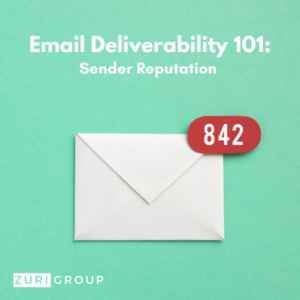This the second post in an ongoing series about email deliverability. Post #1 is about good email list health and can be found here.

It’s almost quaint to think about a time when you could just write an email to your constituents, click send, and have it simply arrive in their inbox.
Alas, those times are gone.
These days, getting your emails from your team’s fingertips to your constituents’ inboxes requires both know-how and best practices as email service providers (ESPs) change their algorithms that might relegate your organization’s emails to various hidden tabs or – worse – spam folders.
Last week we discussed good email list health and best list acquisition practices. This week we’ll dive deeper into the idea of sender reputation, which includes what to actually do with those email lists you now know how to cultivate, edit, and maintain.
What is “sender reputation?”
Every credible ESP wants to protect its users from spam, fraud, and unwanted emails. Their goal is to make sure only the emails the user wants to receive are the emails the user receives. Every IP is assigned a “sender reputation score” from 0-100 that tells an ESP whether to send the email to their user’s junk folder or inbox.
Your organization’s sender reputation is made up of a few factors, weighted differently. These include:
- List health (discussed in post 1 of this series)
- Sending frequency
- Open/engagement rates
- Content
- End user complaints
- Authentication (which will be discussed in depth next)
Utilizing best practices with all these areas will tell ESPs you are not a malicious sender, which will in turn land your emails where they are meant to be.
Tips to improve your reputation
While there is no magic wand to wave to help your sender reputation, there are some actionable steps you can take.
- Maintain your lists.
After you have implemented your best list acquisition practices (go here for the refresher!), maintaining your lists is pivotal. Make sure you update your suppression lists are kept up-to-date from your unsubscribes, hard bounces, and spam reports as continuing to email them will result in ESPs sending your email straight to users’ junk folders. Periodically removing subscribers who have not opened or interacted with your emails for a while will also help boost your score as well. - Use authentication.
We will go into more much detail in a future blog post, but utilizing various authentication protocols from your IP (such as DMARC, SPF, DMARC, etc.) is one aspect of your sender reputation that is fully under your control. Authentication is one aspect around sender reputation we highly recommend to all clients. - Quality content is better than quantity content.
After checking to whom your lists are going, you must be sure to always check the “what.” Best content practices include functional links, avoiding spam words, utilizing a mobile-optimized template, and never sending just a single image as the body of the email. - Check your sender score.
If this reminds you of your personal credit score, that would actually be pretty accurate. Your sender score is ranked from 0-100 and tells you how reputable your IP appears to various ESPs. Sites such as Sender Score, TrustedSource (run by McAffe), and ReputationAuthority are a few examples you can check periodically and take actions if necessary.
If you are worried your organization’s emails are heading to your constituents’ junk folders, it could be worth looking into your sender reputation. As always, Zuri Group is here to answer questions and can offer both resources and expertise if you need them.
 As Vice President of Digital Services, Molly helps nonprofit organizations develop digital solutions to communicate their mission, reach monetary goals, and create real world impact. Molly believes in the power of technology for change.
As Vice President of Digital Services, Molly helps nonprofit organizations develop digital solutions to communicate their mission, reach monetary goals, and create real world impact. Molly believes in the power of technology for change.
